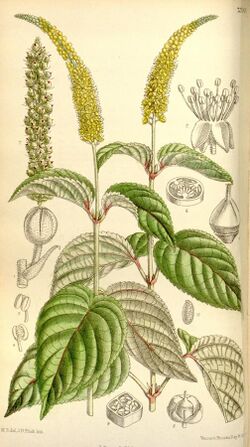Abatia
Topic: Biology
 From HandWiki - Reading time: 2 min
From HandWiki - Reading time: 2 min
| Abatia | |
|---|---|

| |
| illustration of Abatia angeliana | |
| Scientific classification | |
| Kingdom: | Plantae |
| Clade: | Tracheophytes |
| Clade: | Angiosperms |
| Clade: | Eudicots |
| Clade: | Rosids |
| Order: | Malpighiales |
| Family: | Salicaceae |
| Subfamily: | Salicoideae |
| Tribe: | Abatieae |
| Genus: | Abatia Ruiz & Pav. |
| Species | |
| |
| Synonyms | |
| |
Abatia (syn. Raleighia Gardner) is a genus of about ten species of Central and South American trees in the family Salicaceae (following the Angiosperm Phylogeny Group classification). Previously, it was treated in the family Flacourtiaceae, or tribe Abatieae of the family Passifloraceae (Lemke 1988) or Samydaceae by G. Bentham & J.D. Hooker and Hutchinson.
Its native range stretches from Mexico to northern Argentina. It is also found in Bolivia, Brazil, Colombia, Costa Rica, Ecuador, and Peru.[1]
Abatia has opposite leaves with very small stipules and marginal glands at the base of the blade of the leaf. The valvate (meeting at the edges without overlapping) perianth (sepal and petal together) members are closely joined at the base. They bear many filamentous processes.
The leaves of A. rugosa and A. parviflora are source of black dye in Peru.[2]
The genus name of Abatia is in honour of Pedro Abad y Mestre (1747–1800), a Spanish apothecary and professor of botany in Seville, Spain.[3] It was first described and published in Fl. Peruv. Prodr. Vol.78 on table 14 in 1794.[1]
References
- ↑ 1.0 1.1 "'Abatia Ruiz & Pav. | Plants of the World Online | Kew Science" (in en). https://powo.science.kew.org/taxon/urn:lsid:ipni.org:names:30426675-2.
- ↑ Samuel Frederick Gray, A supplement to the pharmacopœias
- ↑ Burkhardt, Lotte (2018) (in German) (pdf). Verzeichnis eponymischer Pflanzennamen – Erweiterte Edition. Berlin: Botanic Garden and Botanical Museum, Freie Universität Berlin. doi:10.3372/epolist2018. ISBN 978-3-946292-26-5. https://doi.org/10.3372/epolist2018. Retrieved 1 January 2021.
Other sources
- Bernhard, A. 1999. Flower structure, development, and systematics in Passifloraceae and in Abatia (Flacourtiaceae). Int. J. Plant Sci. 160: 135–150, illus.
- Sleumer, H.O.(1980). Flacourtiaceae.Flora Neotropica 22:55–57. [monographic revision of the genus]
- Lemke, D. E.(1988).A synopsis of Flacourtiaceae.Aliso 12:28-43. [Tribe Abatieae transferred from Flacourtiaceae to Passifloraceae]
Wikidata ☰ {{{from}}} entry
 |
 KSF
KSF